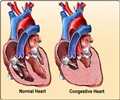Highlights
- Socioeconomic factors may predict the risk of heart failure.
- Compared to health factors and socioeconomic status, factors that consider wealth, education, occupation and housing patterns with regard to a neighborhood influences heart failure risk.
- As neighborhood socioeconomic factors worsened between one group to the next, the risk of heart failure increased by 12%.
The research team grouped the participants (average age 55, 69 percent African-American, 63 percent women) in three groups ranging from the least-deprived to the most-deprived neighborhoods. During an average follow-up of more than five years, 4,300 participants were diagnosed with heart failure.
Researchers noted that residents living in more socioeconomically deprived areas were at the highest risk for heart failure. As neighborhood socioeconomic factors worsened between one group to the next, researchers noted a 12 percent increase in the risk of heart failure. After adjusting for other factors, researchers say 4.8 percent of the variance in heart-failure risk was explained by neighborhood factors.
"There is existing evidence suggesting strong, independent associations between personal socioeconomic status - like education, income level and occupation - and risks of heart failure and many other chronic diseases," said Loren Lipworth, Sc.D., the study's co-senior author and associate professor of epidemiology at Vanderbilt University Medical Center in Nashville, Tennessee.
"But what this study adds is evidence suggesting that characteristics of your place of residence, actually also play a significant role in influencing the risk of heart failure over and above the role of your own individual socioeconomic characteristics," she said. "It opens the door for possible interventions that center on preventive measures in the community."
Study participants were from the Southern Community Cohort Study (SCCS) - an ongoing prospective investigation of cancer and other chronic conditions in a largely resource-limited, underinsured group of recruits in 12 Southeastern states.
How To Reduce The Risk of Heart Failure?
Researchers suggest residents may benefit most from improvements in community resources such as exercise facilities, healthy food outlets and medical facilities.
"Increased and improved access to community-level resources could mitigate cardiovascular disease risk factors like obesity, hypertension, and diabetes," said Elvis Akwo, M.D., Ph.D., first author of the study and a postdoctoral research fellow at Vanderbilt University Medical Center. "Improved community-level resources may ultimately reduce the risk of heart failure in these communities."
The American Heart Association and other organizations recognize that improvements in cardiovascular health require strategies that target the entire spectrum of health and wellness, including public policy changes, prevention efforts, and treatment. The focus on public policy and prevention may have the greatest potential to mitigate the burden of cardiovascular disease and improve overall health.
An accompanying editorial by Wayne Rosamond Ph.D.; M.S. and Anna Johnson, Ph.D.; MSPH, said this research adds an important aspect to our understanding of the role of a neighborhood in health by focusing on low-income neighborhoods.
"By conducting this study in a predominantly low socioeconomic status (SES) population, the potential for bias from individual SES is reduced, allowing for a direct interpretation of associations of neighborhood aspects with heart failure incidence," Rosamond and Johnson wrote.
However, the study's focus primarily on low-income, middle-aged adults limits it from being generalized to other groups. But researchers believe the emphasis on this population - now and in the future - provides much-needed research attention on a segment of people who have been underrepresented in previous cardiovascular studies.
Reference
- Loren Lipworth, Edmond Kabagambe, Frank Harrell, William Blot, Justin Bachmann, Thomas Wang, Deepak Gupta. ‘Neighborhood factors may predict heart failure.’ Circulation: Cardiovascular Quality and Outcomes (2017).
Source-Medindia
















